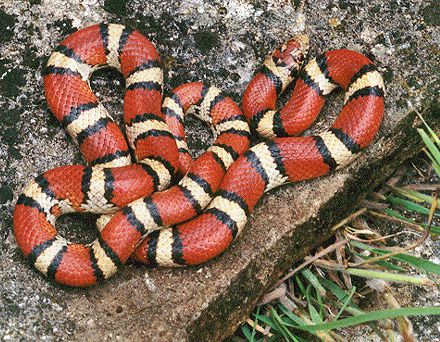-
 Hirudiniasis
Hirudiniasis
-
 Anther
Anther
-
 Whitebeam
Whitebeam
-
 Confocal microscope
Confocal microscope
-
 Angelica
Angelica
-
 Refringence
Refringence
-
 Mediastinum
Mediastinum
-
 Tetrapods
Tetrapods
-
 LINAC
LINAC
-
 Clostridium botulinum
Clostridium botulinum
-
 Protist
Protist
-
 Undulated green slate
Undulated green slate
-
 Mangrove
Mangrove
-
 Scrapie
Scrapie
-
 Colorectal
Colorectal
-
 Blepharitis
Blepharitis
-
 Eclipse
Eclipse
-
 Alzheimer's disease
Alzheimer's disease
-
 Megacycle
Megacycle
-
 Giant sequoia
Giant sequoia
-
 Suborbital
Suborbital
-
 Self-palpation
Self-palpation
-
 Pinot noir
Pinot noir
-
 Colon
Colon
-
 HDMI
HDMI
-
 Solenodon
Solenodon
-
 Lithology
Lithology
-
 Router
Router
-
 CNG
CNG
-
 M44
M44
Aposematism
Aposematism is all of the mechanisms used by animals to send signals to possible predators to let them know that they are not edible.
The signal can be a sound, a chemical or visual. Frogs in the Dendrobatidae family are easily recognised by their bright colours and are highly toxic.
Aposematism and mimicry
The animal emitting this signal can be toxic or non-toxic to its predator. If it is indeed a non-toxic organism, this is called mimicry -the animal adopts the behaviour or appearance of a toxic species -this is called Batesian mimicry, after the British naturalist Henry Walter Bates, who first described this strategy.
The false coral snake, for example, is a non-offensive species for its predators. But as it has roughly the same appearance as the coral snake, which is venomous, it succeeds in deterring its predators.
 The false coral snake, which lives in America, looks like the coral snake and therefore uses aposematism. © BillC, Wikipedia, cc by sa 3.0
The false coral snake, which lives in America, looks like the coral snake and therefore uses aposematism. © BillC, Wikipedia, cc by sa 3.0
Latest
Fill out my online form.



